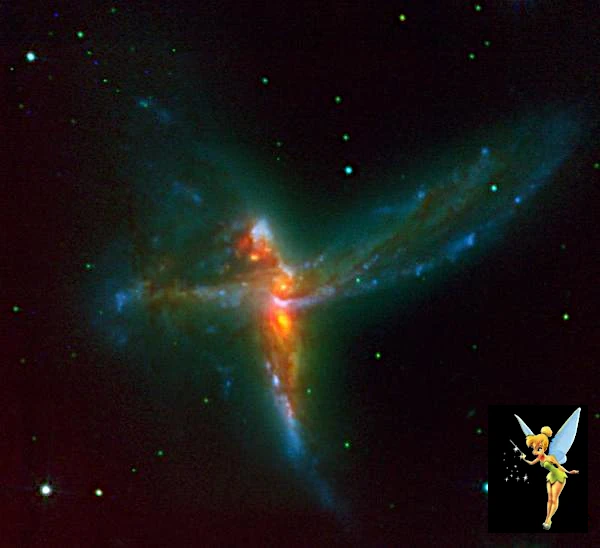
In the vastness of the cosmos, some galactic mergers escape banality. The Hubble Space Telescope captured one of these rare interactions: the merger of three galaxies forming an aerial and luminous silhouette reminiscent of Tinker Bell. Far more than a play of shapes, this phenomenon results from a complex and fascinating gravitational dynamic.
Galactic mergers usually involve two spiral or elliptical galaxies, but in rare cases, a third comes into play. Here, the three galaxies attract each other in an N-body gravitational dance dominated by their dark matter halos. These galaxies, probably spirals, were once independent. Their trajectories converged following large-scale gravitational interactions, probably within a localized galaxy cluster.
Each galaxy carries with it a retinue of stars, interstellar gas, dust, and an active or inactive nucleus. When they interact, tidal forces deform their spiral arms, causing bridges of matter and tidal tails that extend over tens of thousands of light-years.
The image evoking Tinker Bell is the fruit of this chaotic dynamic. One of the galaxies seems to constitute the luminous "head" of the fairy, while the other two form her ethereal "wings". Interstellar dust reflects the light of newly formed massive young stars in areas of intense star formation. These bluish stars trace elegant curves around the galactic nuclei, visually emphasizing the pattern of a dancing celestial figure.
The observed dynamics cannot be explained solely by visible masses. The halos of dark matter of each galaxy interact first, forming a common potential well into which the stellar disks plunge. This gravitational well generates a transfer of kinetic energy and a dynamic heating of the system, leading to the gradual merger of the galactic nuclei.
Intergalactic gas, on the other hand, is compressed following hydrodynamic shocks between the galactic disks. These shock waves favor the formation of massive stars, mainly in the overlapping zones. These young stars ionize their environment, producing intense UV radiation that enhances the spectacular visual aspect of the whole.
This three-way merger will end in several hundred million years with the coalescence of the galactic nuclei. The likely result will be a giant elliptical galaxy, sterile in terms of star formation, but containing the relics of billions of stars from the three parent galaxies. This process is analogous to what has shaped some of the largest galaxies in the observable Universe.
The analogy with Tinker Bell is not just a visual fantasy. It reminds us how nature can generate astonishingly aesthetic structures, resulting from rigorously determined physical interactions. The beauty of astrophysical phenomena is not limited to their visual aspect: it also lies in the complexity of the fundamental forces that orchestrate them.